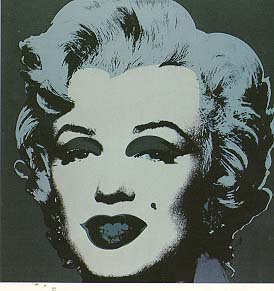Two readings of Andy Warhol: (Foster in MacCabe 118)
- his images as referential: Underneath the glamorous surface of commodity fetishes and media stars [Thomas] Crow finds 'the reality of suffering and death': the tragedies of Marilyn, Liz and jackie in particular are said to prompt 'straightforward expressions of feeling'.
- his images as simulacral: e.g. Roland Barthes: "What Pop art wants. . . is to desymbolize the object," that is, to release the image from deep meaning into (metaphoric association or metonymic connection) into simulacral surface. "The pop artist does not stand behind his work. . . and he himself has no depth: he is merely the surface of his pictures, no dignified, no intention, anywhere."
- Warhol: "If you want to know all about Andy Warhol, just look at the surface of my paintings and films and me, and there I am. There's nothing behind it."
"The point is not to decide
if Warhol's work is subversive of commodity culture either actively, thanks
to the violence of a critical apprehension of it, or passively, through
the endless reflection of its infinite repetitiveness. Nor is the point
to establish if Warhol is fully, consciously and cynically explointing
the very culture he both embraces and opposes. The tension between the
dandy and the flaneur shows that the condition of modern art is schizophrenic,
constitutionally divided so that no individual talent can counteract the
discrepancies that inhabit it." (Lombardo in MacCabe 37)
Andy Warhol mottos:
- "I want to be a machine."
- "I like boring things." "I like things to be exactly the same over and over again."
- "I don't want it to be essentially the same--I want it to be exactly the same. Because the more you look at the same exact thing, the more the meaning goes away, and the better and emptier you feel." (Foster in MacCabe 119)
 Toy
Paintings: Four Monkeys. 1983.
Toy
Paintings: Four Monkeys. 1983.
 Marilyn,
1967.
Marilyn,
1967.  Marilyn,
1967.
Marilyn,
1967.
 Marilyn
Monroe, 1967.
Marilyn
Monroe, 1967.
 Six
Moon Explorers, 1963.
Six
Moon Explorers, 1963.
 Mao, 1972.
Mao, 1972.
 Self
- Portrait, 1967.
Self
- Portrait, 1967.
Osterwold, Tilman. Pop Art.
MacCabe, Colin, et al, eds. Who Is Andy Warhol? Pittsburgh, PA: The British Film Institute and The Andy Warhol Museum, 1997.